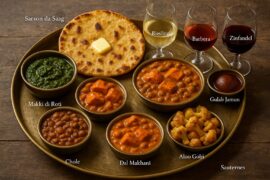Welcome to an exploration of flavor, heritage, and thoughtful wine pairing of the Punjabi thali—an assortment of classic North Indian dishes—is a symphony of spices, textures, and aromas. Instead of a single wine for the entire thali, we present a tasting menu approach, pairing each component with a wine that enhances its unique character.
Main Components
- Roti/Paratha/Makki di Roti – Freshly made Indian breads, often with ghee or butter. In winter, makki di roti (cornmeal flatbread) is common.
- Rice – Usually plain basmati rice or jeera (cumin) rice.
Vegetable & Lentil Dishes
- Dal Makhani – Slow-cooked black lentils with cream and butter.
- Chole – Spiced chickpea curry.
- Sarson da Saag – Mustard greens cooked with spices (a winter favorite).
Paneer Dish
- Shahi Paneer or Paneer Butter Masala – Rich tomato and cream-based curry with Indian cheese.
Accompaniments
- Raita – Yogurt with cucumber or boondi (crispy gram flour pearls).
- Pickle (Achar) – Spicy and tangy fermented vegetables.
- Onion/Lemon Salad – Sliced onions, green chili, and lemon wedges.
- Papad – Thin, crispy lentil wafers.
Dessert
- Kheer – Sweet rice pudding.
- Gulab Jamun – Deep-fried milk balls soaked in sugar syrup.
The whole thali is served in small bowls (katoris) arranged on a large steel or brass plate, offering a balanced mix of flavors—spicy, creamy, tangy, and sweet.
🥬 Sarson da Saag & Wine Pairing
Cultural Context: A rustic winter delicacy of mustard greens, traditionally eaten with makki di roti. Key Ingredients: Mustard greens, spinach, ghee, garlic, ginger. Flavor Profile: Earthy, creamy, slightly bitter.
Science of Pairing:
- Bitterness and greens demand medium acidity and soft texture.
- Avoid tannic reds; opt for fresh, herbal whites or soft reds.
Pairing Wines:
- Grüner Veltliner (Austria) – Green notes echo the saag’s vegetal character.
- Aged Chenin Blanc (Loire Valley) – Balanced texture and mild acidity.
- Gamay (Beaujolais Villages) – Low tannins, bright red fruit.
🍛 Paneer Butter Masala & Wine Pairing
Cultural Context: Rich, celebratory dish from Punjabi feasts. Key Ingredients: Tomato, cream, butter, paneer, fenugreek. Flavor Profile: Creamy, sweet-savory, gently spiced.
Science of Pairing:
- Cream smooths spice; acidity lifts the richness.
- Slight sweetness complements the dish.
Pairing Wines:
- Off-Dry Riesling (Mosel) – Bright acidity and gentle sweetness.
- Viognier (California) – Full-bodied with stone fruit.
- Pinot Noir (Oregon) – Light, earthy red that won’t overpower.
🫘 Dal Makhani & Wine Pairing
Cultural Context: A slow-cooked lentil classic, creamy and comforting. Key Ingredients: Urad dal, kidney beans, cream, tomato, butter. Flavor Profile: Silky, earthy, smoky, mild spice.
Science of Pairing:
- Cream allows for richer wines; needs softness and depth.
Pairing Wines:
- White Rhône Blend (Marsanne/Roussanne) – Viscous and balanced.
- Merlot (Right Bank Bordeaux) – Supple and smooth with red fruit.
- Fiano (Italy) – Textural white with herbal notes.
🧅 Chole (Chickpea Curry) & Wine Pairing
Cultural Context: Staple of Punjabi kitchens and street food. Key Ingredients: Chickpeas, amchur, tomato, onion, spices. Flavor Profile: Tangy, spiced, hearty.
Science of Pairing:
- Tang from amchur calls for high-acid wines.
- Fruitiness offsets spice.
Pairing Wines:
- Albariño (Spain) – Fresh, citrusy, crisp.
- Barbera (Italy) – Juicy acidity and light tannins.
- Grenache (France or Australia) – Red fruit and spice.
🥔 Aloo Gobi & Wine Pairing
Cultural Context: Homestyle dry curry of cauliflower and potatoes. Key Ingredients: Cumin, turmeric, cauliflower, potatoes. Flavor Profile: Earthy, warm, dry.
Science of Pairing:
- Mineral whites or earthy reds complement dry spice.
Pairing Wines:
- Sauvignon Blanc (Loire) – Zippy and green.
- Mencia (Spain) – Soft, floral, red-fruited.
- Dry Muscat (Alsace) – Floral and aromatic.
🍯 Gulab Jamun & Wine Pairing
Cultural Context: Iconic dessert of fried milk balls in syrup. Key Ingredients: Khoya, sugar, rose water, cardamom. Flavor Profile: Syrupy, floral, rich.
Science of Pairing:
- Needs a wine with matching sweetness and floral lift.
Pairing Wines:
- Moscato d’Asti (Italy) – Bubbly, floral, not cloying.
- Late Harvest Gewürztraminer (Alsace) – Perfumed and lush.
- Tokaji Aszú (Hungary) – Sweet with balancing acidity.
🍷 Unexpected Pairings
- Dry Sherry (Amontillado) – Saline and nutty, ideal with dal or saag.
- Bandol Rosé (France) – Structured and spicy, handles paneer butter masala.
- Skin-Contact White (Orange Wine) – Great with aloo gobi or lentils.
⚠️ Wines to Avoid & Common Mistakes
| Mismatched Pairing | Why It Doesn’t Work | Better Alternative | Example Wine | Example Reason | Suggested Wine |
|---|---|---|---|---|---|
| Oaky Chardonnay | Overpowers spices, adds unwanted weight | Grüner Veltliner | Napa Chardonnay | Oak clashes with spice | Grüner, Chenin Blanc |
| Tannic Reds | Spice amplifies bitterness | Gamay or Pinot Noir | Cabernet Sauvignon | Too astringent | Gamay, Cab Franc |
| High-Alcohol Zinfandel | Heat intensifies with alcohol | Off-Dry Riesling | 15% Zinfandel | Burns with chili | Mosel Riesling |
💡 Final Thoughts & Expert Tips
- Match intensity: Heavier dishes need bolder wines.
- Balance spice with acidity and gentle sweetness.
- A fun fact: The Punjabi tradition of eating saag with lassi inspired our preference for off-dry, creamy whites!
🍽️ Recipe: Paneer Butter Masala (Wine-Friendly)
Ingredients:
- 250g paneer, 1 cup tomato puree, 2 tbsp butter, 2 tbsp cream, ginger-garlic paste, garam masala, kasoori methi, chili powder, salt.
Preparation:
- Sauté ginger-garlic paste in butter.
- Add tomato puree; cook down.
- Add spices, salt, and kasoori methi.
- Stir in cream, add paneer, simmer gently.
Wine Modifications:
- Reduce chili by 25%.
- Use unsalted butter for better wine harmony.
Serving Tips:
- Garnish with cilantro and julienned ginger.
- Pair with chilled off-dry Riesling (50°F).
Explore Punjabi cuisine like never before—through the lens of wine. Treat your thali like a tasting flight and savor each dish in harmony.

